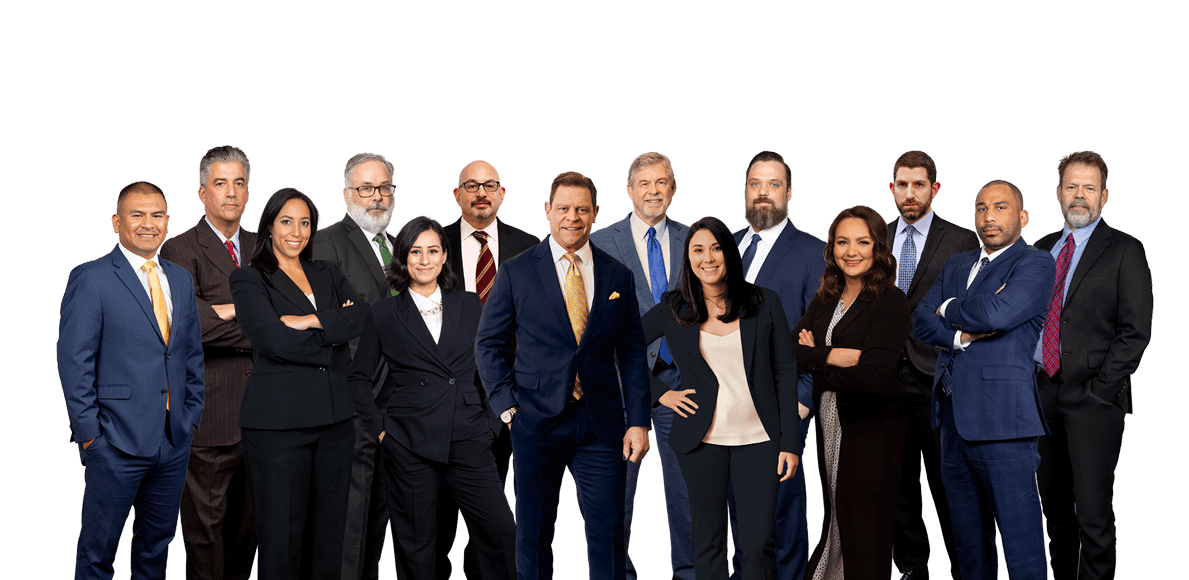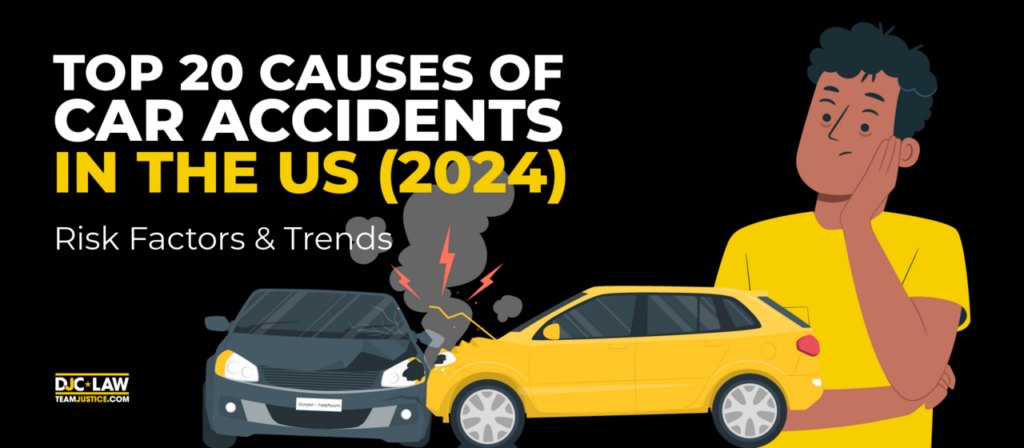
According to the National Safety Council, there were 46,027 motor-vehicle deaths in 2022 [1]. With more cars on the road than ever, your chances of being involved in an incident continually increase. But why do accidents happen, and what can you do to reduce your risk?
Let’s discuss the primary reasons why car accidents occur in the U.S. in 2024 to find out where injuries and deaths are coming from.
Key Takeaways
The top causes of car accidents on America’s roads in 2024 include speeding, distracted driving, and driving under the influence.
Accidents and deaths have remained relatively stable, with significant variations between states.
Drivers should practice safe driving techniques to reduce their risk of being involved in an accident, including reducing their speeds, adapting to the conditions, and driving defensively.
After an accident, victims should prioritize their safety and call law enforcement before gathering evidence and seeking medical attention.
Work with a lawyer to pursue your personal injury claim to increase your chances of winning your case and maximizing your compensation.
What are the Top Causes of Car Accidents on the Road?
Of course, most experts focus on reducing deaths, but even minor injuries are traumatizing for those who experience them. According to a report from MarketWatch, 2.4 million Americans sustained injuries in 2022, and that’s just too high [2].
In this section, we’ll cover the leading 20 causes of car accidents you’ve got to watch out for.
1. Speeding
Speeding is by far the biggest cause of accidents in the U.S. Surpassing the speed limit gives you less time to react to hazards and increases the chances of losing control of your vehicle, especially in poor weather conditions.
The National Safety Council found that speeding contributed to 29% of all fatal car accidents in 2022 [3]. That’s about 33 people killed daily!
All age demographics speed, but Radarsign reported that 40% of speeding drivers involved in a fatal crash were between 16 and 24 years of age. And people agree that speeding kills, with 47% of drivers believing it is the leading cause of all accidents [4].
2. Distracted Driving
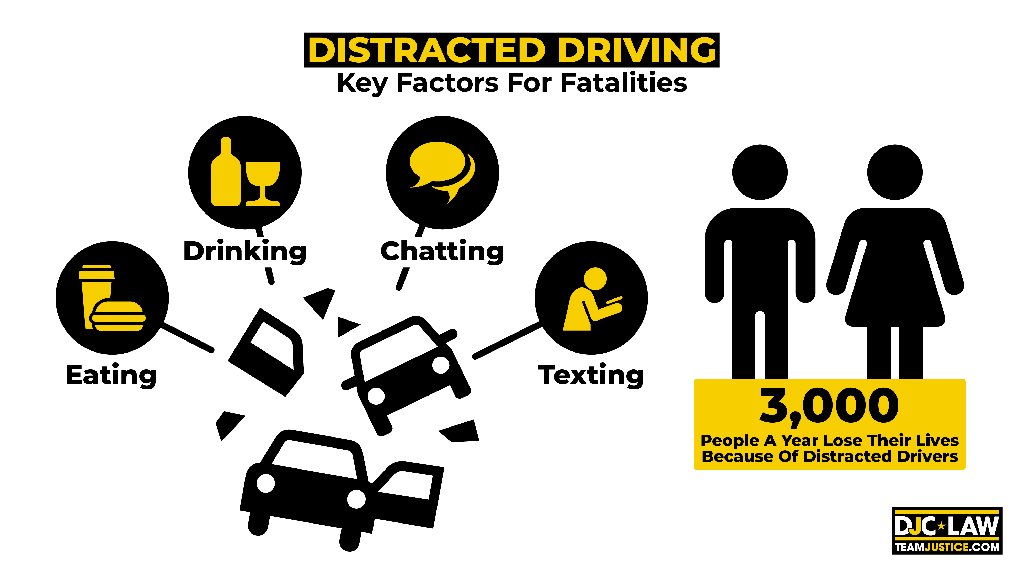
Distracted driving is anything that draws your attention from the task at hand. Whether it’s not keeping both eyes on the road, keeping two hands on the wheel, or letting your mind wander, distracted driving is the 2nd leading cause of injury and death on the roads.
Driving feels like it’s become an apathetic activity, with Americans eating, drinking, chatting, and texting on their cell phones. And the numbers bear that out, with Forbes revealing that around 3,000 people a year lose their lives because of distracted drivers [5].
What is Drowsy Driving?
Drowsy driving means being fatigued at the wheel. In the worst-case scenario, drowsy driving results in falling asleep at the wheel. Many experts claim that driving tired is just as bad as driving drunk because your reaction times decrease, and you lose the ability to perceive hazards.
The National Highway Traffic Safety Administration (NHTSA) found that 91,000 of reported crashes in 2017 involved drowsy drivers [6]. It illustrates how critical it is to pull over and take a break if you’re struggling to maintain focus because it could just save your life.
3. Running Red Lights
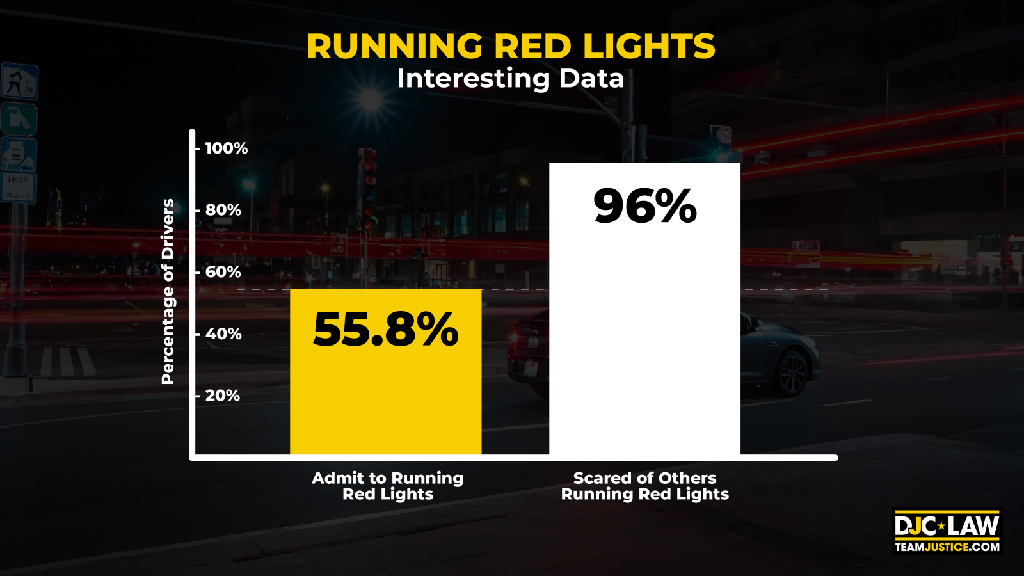
Running a red light means not coming to a complete halt when you see the traffic signal turn red. Entering an intersection when the light turns red isn’t just an offense but also a big cause of motor vehicle accidents because other drivers aren’t expecting you to be there.
According to the Cherokee County government of Georgia, 55.8% of Americans admitted to running red lights. The wild thing is that 96% of drivers admitted to being scared of others doing the same thing [7].
4. Running Stop Signs
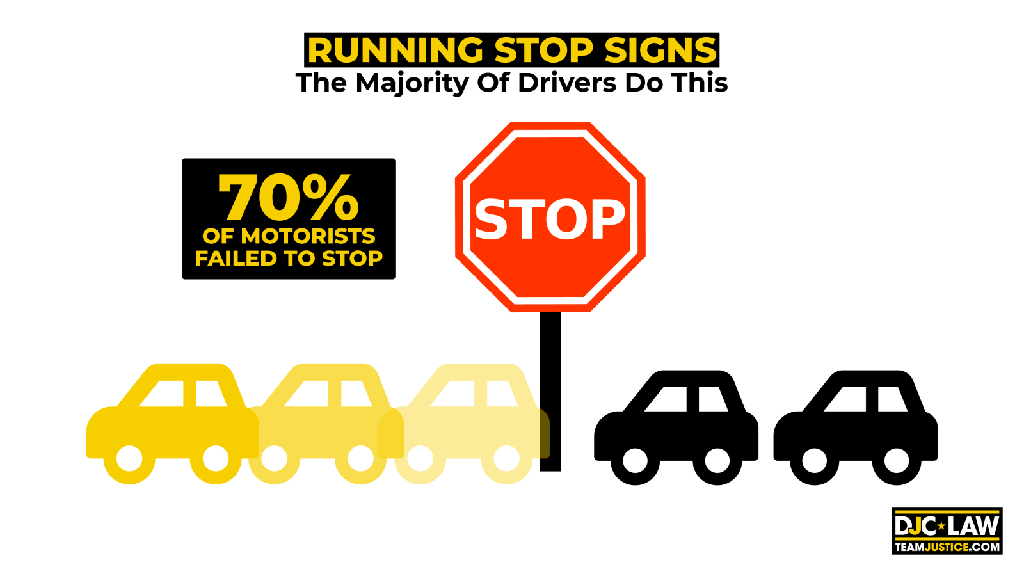
Stop signs manage traffic flow by assigning right of way at intersections. They’re designed to prevent the battle royales that lead to drivers aggressively trying to assert their right of way. Traffic law requires you to halt at stop signs, but Americans routinely fail to do this.
According to the Pasadena Weekly, almost 70% of motorists failed to stop at stop signs if they didn’t see any competing traffic [8]. It makes logical sense when you think about it, but the problem is you don’t know who’s coming, which leads to many fatal car accidents.
5. Drunk Driving
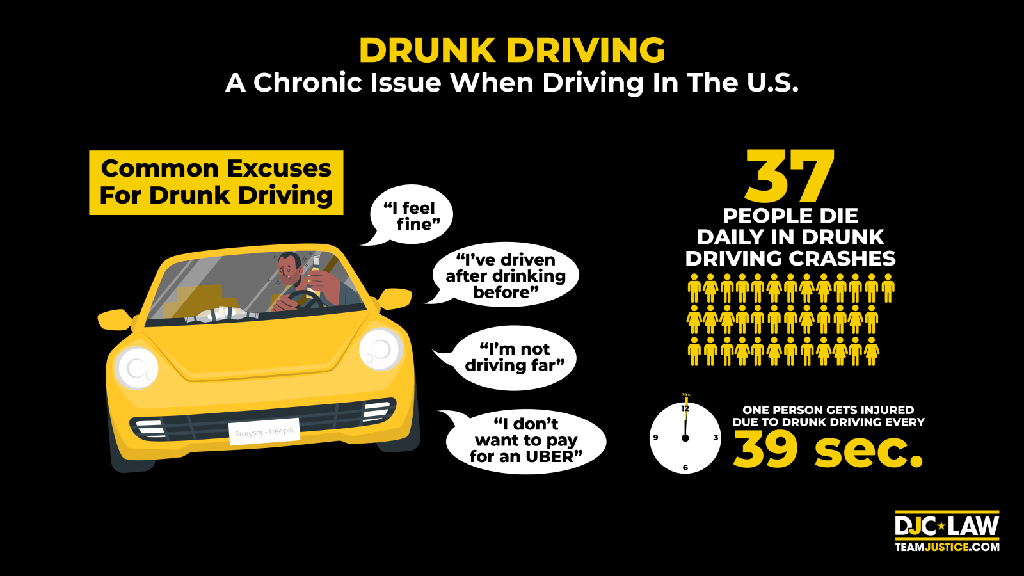
Drunk driving remains a chronic issue. Getting behind the wheel while drunk or high naturally impairs your ability to control your vehicle and react to hazards. Impaired driving is when your blood alcohol content (BAC) is 0.08% or higher. You’re legally impaired and cannot drive, which is the equivalent of four 12-ounce beers over two hours.
According to MADD, 37 people die daily in drunk driving crashes, or one person gets injured every 39 minutes [9]. Despite constant safety campaigns, too many people continue to take risks and experience disastrous results, with some of the most common excuses being:
I feel fine.
I’ve driven after drinking before.
I’m not driving far.
I don’t want to pay for an Uber.
It’s never safe to drink and drive. Even if you’re under the limit, most safety experts recommend not driving at all if you’ve consumed any alcohol.
6. Poor Weather
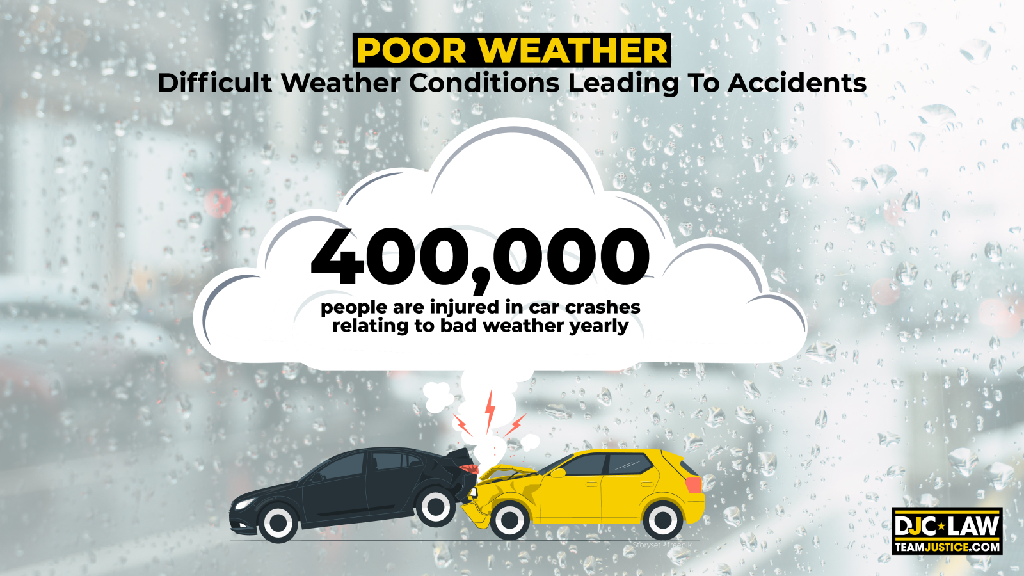
Poor weather contributes to deaths because changing road conditions mandates a change in driving style. Too many motorists drive in snow, wind, and rain as they would in dry, sunny conditions, leading to misjudging braking distances and aquaplaning in poor visibility conditions.
According to the U.S. Department of Transportation, over 418,000 people are injured in car crashes relating to bad weather yearly [10]. That’s why it’s vital to understand the types of weather conditions you might encounter in your area and to adjust how you drive accordingly.
7. Road Rage
Road rage is when drivers become aggressive and angry on the roads. It could lead to unnecessary risk-taking or confrontation that leads to tragedy. People are more stressed and impatient than ever, so road rage remains a constant problem nationwide.
Unfortunately, road rage is becoming a bigger problem than ever. Bankrate released several stats, including [11]:
Road rage shootings increased by 449% between 2014 and 2023.
481 people were shot in 2023 in road rage incidents.
3,095 people were shot in road rage incidents between 2014 and 2023.
An inability to take a deep breath and stay calm behind the wheel continues to be a persistent problem, and it’s one of the few accident causes that has grown rather than fallen, especially in the aftermath of the COVID-19 pandemic.
8. Improper Turns
Turning when you shouldn’t might stop you from doubling back, but it also puts you in harm’s way because other drivers aren’t expecting you to make that turn. Some fatal car accidents happen out of laziness, but others occur because drivers ignore the rules of the road.
For example, the City of Chicago often lets you stop at red lights and turn right at intersections, but you can’t stop at a red light and then turn left. According to the Federal Highway Administration, almost half of all traffic injuries occur at intersections, with significant numbers involving driver errors like improper turns [12].
9. Reckless Driving
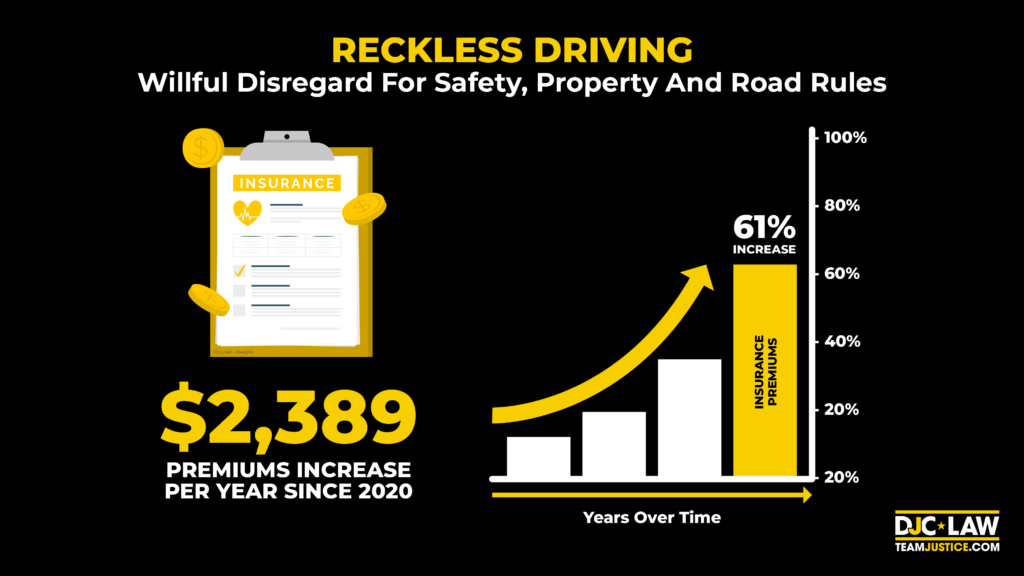
Reckless driving is a willful disregard for safety, property, and the rules of the road. It’s viewed as intentional or conscious indifference, but what counts as reckless driving behaviors vary based on the state. That’s why it’s often a separate charge, depending on where you are.
For example, some states might classify going 10 mph over the limit as a simple speeding ticket, but going 25-30 mph over the speed light suddenly becomes a charge of reckless driving.
Reckless driving is the equivalent of a major moving violation and has a massive impact on how much you pay for insurance because you’re then classified as a “high-risk driver.” According to The Zebra, reckless driving in 2020 raised your premiums by $2,389 per year, a 61% year-on-year increase [13].
10. Teenage Drivers
Teenage drivers experience more accidents than any other age demographic. Teen Driver Source reported that 2,034 drivers between the ages of 15 and 20 were killed in car crashes in 2022 despite making up fewer than 5% of all licensed drivers [14].
It’s no surprise that teenagers are likelier than any other group to find themselves in a sticky situation because:
Teens are less experienced.
Teens are more prone to risk-taking.
Teens are likelier to commit an array of offenses, including speeding and driving under the influence.
This lack of experience and natural inclination to engage in high-risk behaviors is the perfect storm that makes them the riskiest prospects on the road. It’s why teens will always pay higher insurance rates than any other age group on average.
11. Night Driving
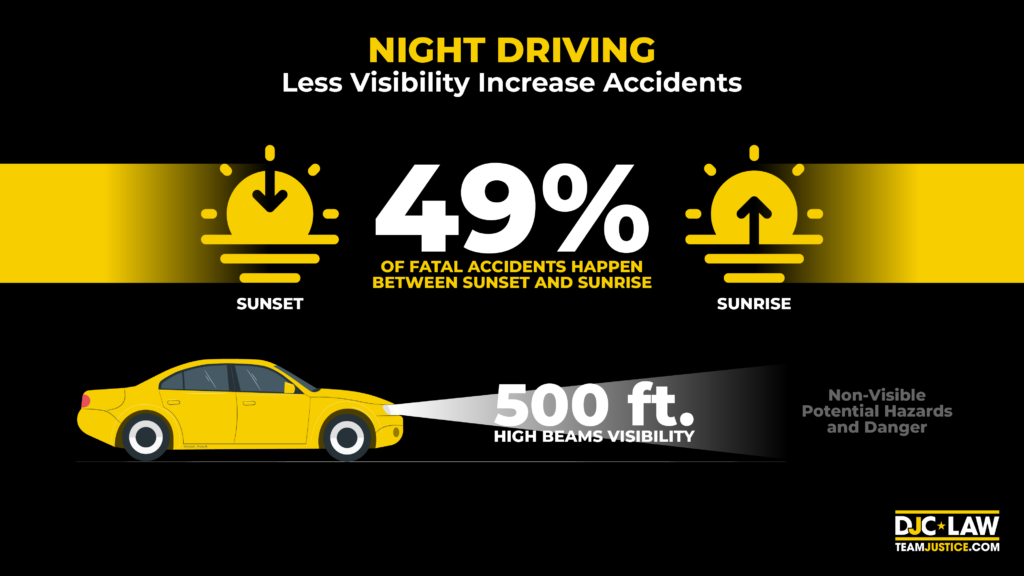
Driving at night is considerably more dangerous than driving during the day. Even with your high beams on, your visibility is still only around 500 feet, giving you less time to react to hazards. Moreover, you’re far likelier to encounter reckless drivers and those driving under the influence after sundown.
A MoneyGeek analysis dug into these numbers and found that nationwide, only 9% of driving miles occur from sunset to sunrise. Yet, 49% of fatal accidents occur at this time [15]. This is another reason some states prohibit nighttime driving for teenagers unless they’re with an adult guardian with a driving license.
12. Vehicle Defects
Poorly maintained cars are another cause of serious car accidents because modern cars are designed to be driven safely when everything works as it should. All vehicles acquire defects as they age, so staying on top of regular maintenance is essential.
For example, many used car buyers don’t check their airbags work. Remember, airbags are only designed to be deployed once before being replaced, so if a vehicle has been in an accident, you might find that your airbags don’t work at the wrong time, thus turning a minor injury into a life-changing one.
According to the National Institutes of Health, these are the most common defects resulting in crashes [16]:
42.02% for brake failures.
22.41% for tire blowouts.
10.81% for improper tire tread depth.
5.64% for defective vehicles.
Interestingly, they also found that 67% of all vehicles involved in crashes were at least ten years old.
13. Unsafe Lane Changes
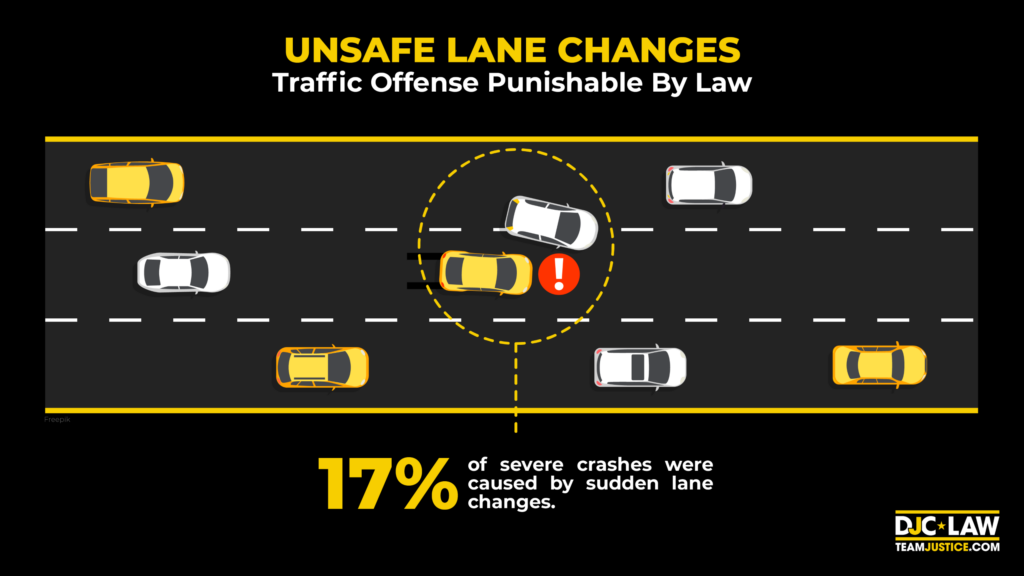
Safely changing lanes means informing other drivers around you that you’re moving lanes. An unsafe lane change can be as simple as not using your car’s signals or only turning on the signals when you’re in the middle of making the lane change. It’s a traffic offense, and you can be ticketed for unsafe lane changes.
Accidents occur because drivers don’t have time to react to your attempt at changing lanes. According to the International Association of Traffic and Safety Sciences (IASS), 17% of severe crashes between 2010 and 2017 were caused by sudden lane changes [17].
14. Animal Crossings
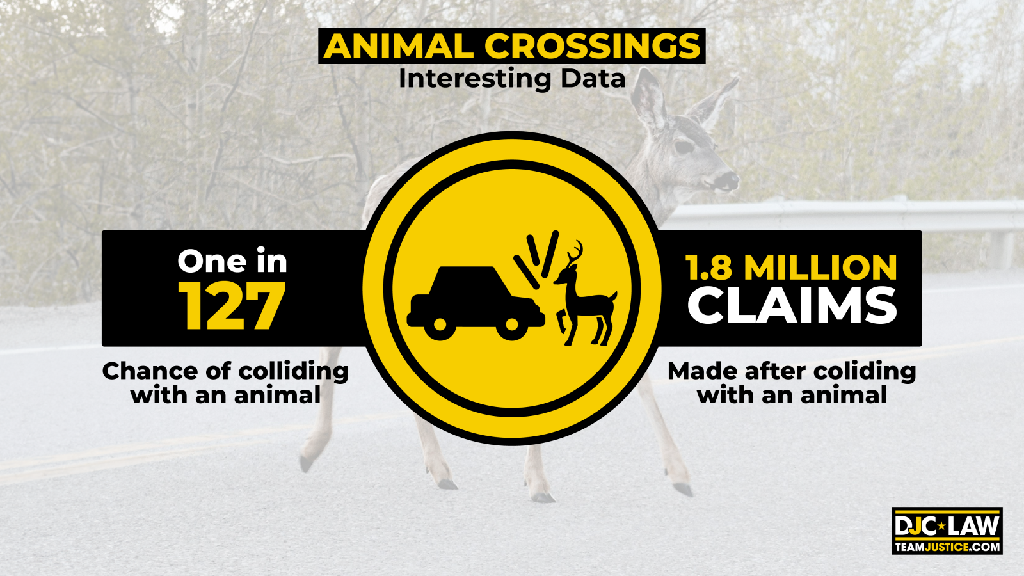
Animals can’t read road signs, so you might encounter a large animal, such as a deer, trying to cross the road while driving. The size of wild animals means that you’re likely to get seriously injured if hitting them at high speeds.
According to State Farm, U.S. drivers have a one in 127 chance of colliding with an animal. They also found that between July 2022 and June 2023, there were more than 1.8 million claims made after colliding with an animal.
Naturally, where you are will determine your chances of colliding with an animal. During this same period, State Farm found that West Virginians had a one in 38 chance of colliding with animals [18].
15. Street Racing
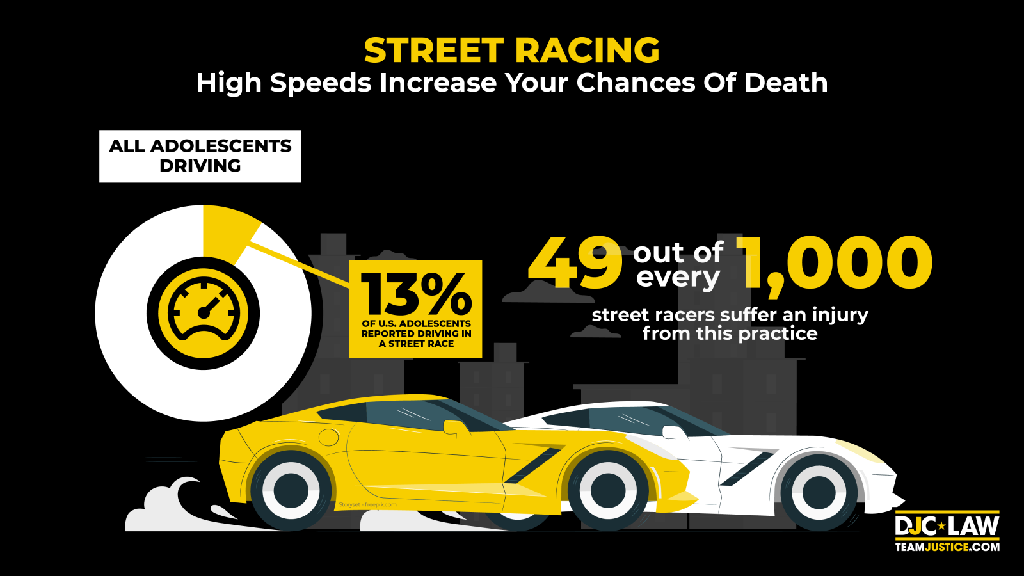
Street racing is illegal, but unsanctioned races continue on public roads. Since ancient times, people have illegally raced animals and vehicles, posing a danger to drivers and pedestrians alike. Not only can it come with jail time, but the high speeds increase your chances of losing your life.
Unsurprisingly, young drivers are likeliest to participate in illegal street racing, with 13% of U.S. adolescents reported driving in a street race, per statistics from the National Institutes of Health [19]. Plus, the Stop Street Racing campaign group revealed that 49 out of every 1,000 street racers suffer an injury from the practice [20].
16. Aggressive Driving
Aggressive driving is a willful action that puts another driver, pedestrian, or property at risk. It involves multiple moving violations, including speeding, running red lights, road rage, and tailgating.
Like reckless driving, it’s not a felony but a misdemeanor. Depending on the state, it’ll often be considered a less severe misdemeanor than reckless driving, but aggressive driving can still lead to license suspension and even jail time. There’s a fine line between whether something counts as aggressive behavior or if it is classified as aggressive driving.
Octo Telematics found that 78% of drivers admitted to engaging in aggressive behavior, with up to half of drivers honking and purposely tailgating someone else [21].
17. Road Curves
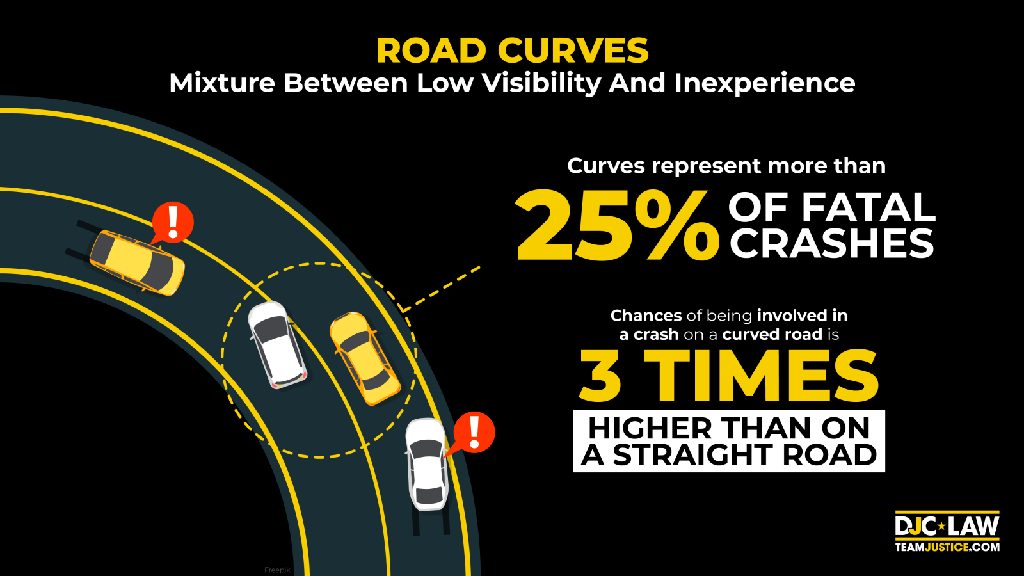
Road curves make up an enormous number of accidents because you often don’t see a driver coming the opposite way until it’s too late. Drivers often fail to slow down upon entry, thus making it impossible to react to a hazard in time.
The Federal Highway Administration found that horizontal curves represent more than 25% of fatal crashes. Moreover, your chances of being involved in a crash on a curved road are about three times higher than on a straight road.
Sadly, drivers fail to heed the advice of slowing down to avoid disaster and focusing on who’s coming the other way.
18. Tailgating
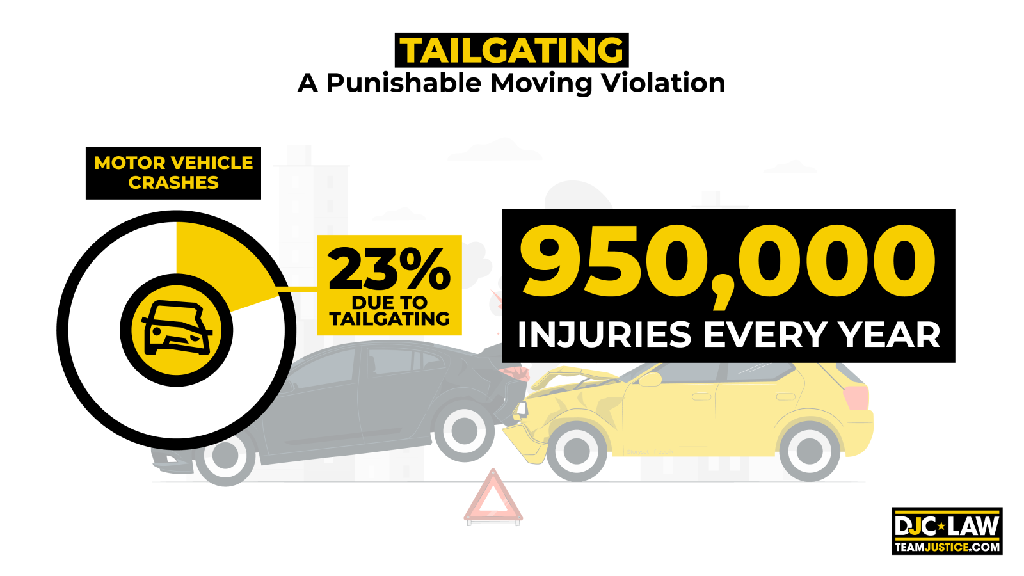
Tailgating means driving too close to the vehicle in front. Sometimes, this happens because people aren’t paying attention, but it’s also a type of road rage, as people drive close to intimidate another driver. Tailgating is a type of moving violation and can result in getting ticketed.
The Texas Department of Insurance reported that rear-end collisions are about 23% of all motor vehicle crashes, with 950,000 injuries every year [23]. Generally, you should follow the three-second rule to avoid tailgating. In other words, when moving, you should always be at least three seconds away from the car ahead.
19. Construction
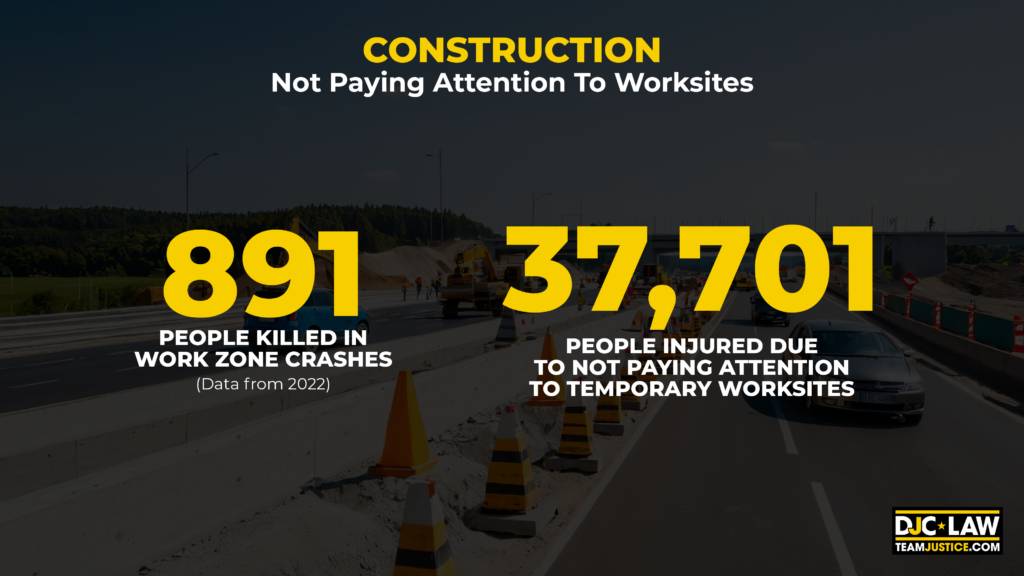
Road construction is another significant cause of accidents because drivers don’t pay attention to these temporary worksites. They might miss a sign warning them of an upcoming construction zone or fail to change their driving accordingly.
The National Safety Council found that 891 people were killed in work zone crashes in 2022, with 37,701 injuries [24]. It’s another accident cause that’s growing upward, with 2021 representing a 17-year high.
20. Wrong-Way Driving
Wrong-way driving means exactly what you think it does. Driving down a road in the opposite direction is more common than many people think, with many of these crashes happening at high speeds on America’s freeways.
Unfamiliar drivers may take a wrong turn or not see the sign for a one-way street, but wrong-way driving also happens because of people driving under the influence. According to the National Conference of State Legislatures, 52.8% of fatalities from wrong-way driving occurred because of driver error [25].
If you’re driving in an unfamiliar area, look for any signs and pay attention to how traffic flows to avoid getting into this situation.
What are Car Accident Trends in the U.S. (2024)?
With these 20 leading causes of auto accidents, what conclusions can we draw from the state of America’s roads?
Every year, traffic safety organizations analyze where their efforts must be focused to keep people safe. In 2024, we can look at the numbers and determine that key trends include:
Early estimates from the Department of Transportation based on a statistical projection predict that 2023 saw a decrease of 3.6% in traffic fatalities [26].
Distracted driving is still one of the leading causes of accidents. With more gadgets in our hands and shorter attention spans, it’s no surprise that distracted driving accident rates remain stubbornly high.
Road rage incidents have risen, especially in the aftermath of COVID-19, indicating that drivers are becoming more aggressive and impatient.
Cities and states are reacting by introducing more stringent traffic enforcement systems, including automated cameras and tougher penalties.
Perceptions of U.S. road safety indicate that roadways are more dangerous today, with Headlight News reporting that 62.3% of motorists agree driving is more dangerous than five years ago [27].
Sadly, there’s been massive variation across states over the last few years. Some have made great strides in reducing roadside tragedies, whereas others have seen increases. Unfortunately, this is why the U.S. is still considered to be behind the global curve on road safety.
Essential Safety Tips to Prevent Car Accidents
Auto accidents number in the millions, but that doesn’t mean everyone will experience a serious car accident. Adopting a defensive driving posture and paying attention to your surroundings go a long way to keeping you and your family safe.
If you’re worried about road safety, follow these essential safety tips to reduce your chances of being involved in an auto accident.
Always Use Seat Belts
Your seat belt could save your life, turning major injuries into minor injuries. Seat belts have saved thousands of lives since they were first added to vehicles in the 1960s, and they continue to be more effective with every generation.
There’s a reason it’s a violation in practically every jurisdiction not to wear your seat belt. So, buckle up and ensure that everyone else buckles up to avoid anyone becoming a human missile.
Drive at a Reasonable Speed
Speed kills, and it’s not just a marketing slogan. The single most effective accident prevention tactic you can employ is to reduce your speed.
Always follow the speed limit on any road, and slow down considerably if driving in wet or icy conditions.
Drive Friendly
Road rage leads to aggression, with drivers making poor decisions that result in entirely avoidable accidents. Demonstrate courtesy when you’re on the road, and if you encounter an aggressive road user, just let them go.
Getting into an accident because of aggression and road rage is needless and isn’t worth “winning” or reaching your destination a couple of minutes early.
Maintain a Safe Following Distance
Tailgating isn’t just a traffic violation but also a necessary rule for keeping you safe. Maintaining a safe distance gives you a few extra seconds to slam on the brakes or swerve if something happens.
Generally, most road safety experts recommend keeping at least a three-second following distance. Remember, the actual distance increases when moving at higher speeds.
Stop at Red Lights and Stop Signs
Red lights and stop signs control the flow of traffic to prevent accidents. Many cities, including Chicago, have now installed special red light cameras that use sensors to automatically catch drivers who fail to stop when they should.
Barreling through a red light or a stop sign puts you at risk because others either aren’t expecting you or don’t have enough time to take evasive action.
Signal Every Turn and Lane Change
Driving is safest when people act predictably. Your turn signals tell other drivers what you’re doing, whether that’s turning down another street or shifting lanes on the freeway.
Turn on your signals, and only then make the maneuver. Ensure that those around you know what you’re doing so they can adjust accordingly.
Always Check Your Car (Maintenance)
Regular car maintenance should be part of your driving routine. You should be taking your vehicle to a garage for a check a couple of times per year and giving it a once over before you take off.
The last thing you want is to discover that your tire has lost its grip or your brakes don’t work when you need it most. Neglecting your vehicle puts you and others at risk, and all to save a few seconds of checking over everything before pulling away.
What to Do If You Are in a Car Accident
Every car crash is a traumatizing event. Walking away is a blessing, but if you’re injured in an accident that wasn’t your fault, you may have a right to compensation. What you do after an accident will influence whether you’re eligible for a settlement and how much you’re entitled to.
These events are emotional, and it’s natural that you might be confused and overwhelmed. Memorize these steps for what to do if you are in a car accident in the immediate aftermath:
Step One – Get you and anyone in the vehicle to safety. Don’t just stand around in the middle of the road because countless accidents turn into multi-car wrecks because people don’t expect to see a wrecked car or a person in the middle of the road.
Step Two – Check yourself and your passengers for any injuries. If there are any serious injuries, call for an ambulance. You should also take the time to request that law enforcement attend. Don’t leave until someone attends.
Step Three – Exchange your details, including insurance information, with other drivers involved. You’re legally required to do this, and trying to leave first could see you being charged with a hit-and-run offense.
Step Four – Take pictures and videos of the scene. Focus on the damage to cars and property, alongside any visible injuries you’ve obtained. Talk to any eyewitnesses who might have seen what happened and take down their contact details for later.
Step Five – Speak to a law enforcement official and ensure they’ve completed and filed an official accident report. Once this is done, visit your nearest medical facility and get checked out. Some injuries might not arise until hours or days after the incident, so it’s vital to ensure you’re okay.
What matters when you’ve experienced a car accident is your personal safety and keeping a calm head. Don’t get angry or aggressive because this could result in a bad situation getting way worse. Call the police and ensure someone attends to work everything out.
When Should You Hire a Car Accident Lawyer?
Car accident attorneys are there to help you file a personal injury claim and assert your legal rights. We recommend calling a lawyer immediately because they’ll also help you deal with your insurer.
Contrary to popular belief, attorneys don’t just file personal injury lawsuits but also ensure you get the maximum settlement from your insurer. Remember, a Chicago car accident lawyer does a great many things, including:
Investigating your accident
Filing insurance claims
Negotiating with insurers
Protecting your legal rights
Representing you in court
After you’ve received the appropriate medical attention, your first call should be to a lawyer. Engaging them early enables you to launch the process of obtaining a settlement.
What are the Benefits of Hiring a Personal Injury Lawyer?
Hiring a personal injury lawyer isn’t an expense but an investment. Not only do they increase your chances of winning your claim, but they also maximize the amount you’re entitled to. Insurance adjusters will try everything possible to get out of paying up, but your personal injury attorney in Chicago is there to hold them accountable.
Here are some of the main benefits of hiring a personal injury lawyer to sort out your car accident claim:
Avoid settling too soon.
Dodgy scare tactics.
Prove the true severity of your injuries.
Take advantage of their legal expertise.
Gather evidence.
Prove who was at fault.
Determine your losses.
Your car accident attorney understands how the systems work and what they need to do to get proper compensation for your losses. Don’t try to handle your case yourself. Instead, put it in the hands of a lawyer who’ll take full control while you concentrate on recovering from your injuries.
1. https://injuryfacts.nsc.org/motor-vehicle/historical-fatality-trends/deaths-and-rates/
2. https://www.marketwatch.com/guides/insurance-services/car-accident-statistics/
3. https://injuryfacts.nsc.org/motor-vehicle/motor-vehicle-safety-issues/speeding/
4. https://www.radarsign.com/traffic-calming-stats/
5. https://www.forbes.com/advisor/legal/auto-accident/distracted-driving-statistics/
6. https://www.nhtsa.gov/risky-driving/drowsy-driving
9. https://madd.org/statistics/
10. https://ops.fhwa.dot.gov/weather/q1_roadimpact.htm
11. https://www.bankrate.com/insurance/car/road-rage-statistics/
12. https://highways.dot.gov/safety/intersection-safety/about
13. https://www.thezebra.com/resources/research/road-rage-statistics/
15. https://www.moneygeek.com/insurance/auto/analysis/dangerous-night-driving/
16. https://www.ncbi.nlm.nih.gov/pmc/articles/PMC10907794/
17. https://www.sciencedirect.com/science/article/pii/S0386111219300020
19. https://www.ncbi.nlm.nih.gov/pmc/articles/PMC6211164/
20. https://stop-street-racing.org/street-racing-stats.htm
21. https://www.octotelematics.com/blog/road-rage-statistics-2022/
22. https://highways.dot.gov/safety/rwd/keep-vehicles-road/horizontal-curve-safety
23. https://www.tdi.texas.gov/pubs/videoresource/fsriskstailgati.pdf
24. https://injuryfacts.nsc.org/motor-vehicle/motor-vehicle-safety-issues/work-zones/
26. https://crashstats.nhtsa.dot.gov/Api/Public/ViewPublication/813561
27. https://headlight.news/2024/08/05/beware-americans-hurtling-toward-deadliest-day-on-u-s-roads/

